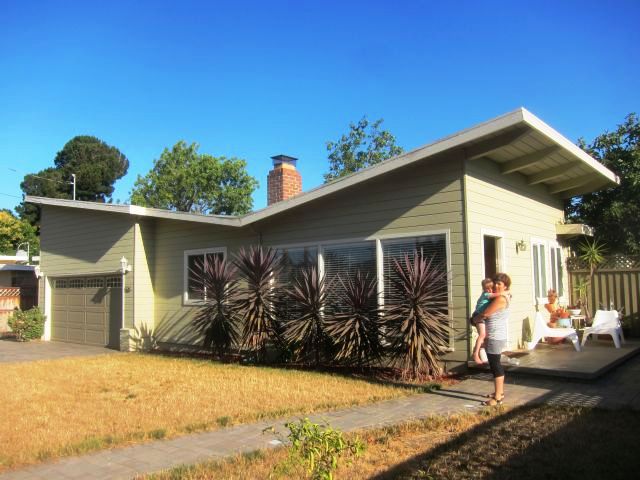
Two Butterflies are Spotted in Early Eichler Tract
 |
|
|
Eric and Françoise Allamanche didn’t exactly fall in love with the look of their newly purchased Eichler home even though it has one of the developer’s most distinctive rooflines – shaped like the wings of a butterfly.
“When we bought this house, the shape was not a feature we were looking for. This side is OK,” says Eric, meaning the side with the living and dining room, “but the garage – it looks a bit bizarre.”
The home in question is part of Sunnymount Gardens, the second subdivision Eichler built as Eichler Homes, way back in mid-1949. Eichler either bought plans or worked with a building designer – this is before he hired architects. It’s safe to say, then, that the Allamanche home, and one a block away in the same neighborhood, are Eichler’s first butterfly roofs.
(Or did we miss any in Joe’s first subdivision, Sunnyvale Manor? We don’t think so.)
 |
|
|
These are also, ironically perhaps, among Eichler’s last butterfly roofs – because he apparently didn’t like them.
Throughout his 25-year career as a homebuilder, Eichler built flat roofs, low gable roofs, high gables roofs – but only a small handful of butterfly roofs. Occasionally one will pop up in a later subdivision, as though on a surprise visit.
Yet some of the architects who designed Eichler’s homes, Anshen and Allen, and especially Jones & Emmons, employed butterfly roofs when working for other builders, and with much panache.
So it’s always fun to visit the butterfly homes that Eichler did build.
We at Eichler Network have a fondness for homes with butterfly roofs because they are so jaunty and can be joyous, truly evoking what is most playful about mid-century modern architecture. It’s not surprising that the heaviest concentration of such butterflies can be spotted in the Southern California playground of Palm Springs.
 |
|
|
Sunnymount Gardens, with about 36 modern Eichler homes and about 30 ranch-style homes that were either built by Eichler, by the account of one neighbor, or built by someone who bought the lots from Eichler, is a compact U-shaped neighborhood encompassing Sunnymount Avenue, Dawn Drive, and a short connector, Dee Street.
The modern homes are on one side of the street, the ranches on the other.
No one but residents drives through, so kids feel free to play in the street, and it’s a quick walk to large and lovely Las Palmas Park, where, inexplicably enough, large Easter Island heads decorate the playground. You can walk to Trader Joe’s and Safeway, Eric notes, and even to Sunnyvale’s lively little remnant of a historic downtown.
Many Eichler fans wouldn’t even recognize these homes as Eichlers. They have glass facing the street and no walls of windows to the rear. They’re built on foundations, not concrete slabs. Nor do they have radiant heat. They do have exposed beams and tongue-and-groove ceilings.
 |
|
|
“In the inside, these houses are very conventional,” Eric says, noting that the kitchens were closed from the living areas. Françoise adds: “It’s not the same feeling [as a later Eichler home].”
And the silhouettes are different – some flat roofed, with high-hats poking up for higher living areas; others have single-sloped shed roofs. The butterflies come about on those homes with two single-sloped roof section, each pointing in a different direction.
Many houses have this roofline – but with most, while one roof section shoots upwards at a steep angle, the other is angled only slightly. These 'wings' don’t quite suggest a true butterfly.
While attractive in their own way, there is something awkward about the look of these early Eichlers, many of which have been updated, enlarged, and modernized over the years. What Eric objects to in the look of his house is the strangely proportioned garage façade.
 |
|
|
Eric and Françoise have a remodel in the works that will add 500 feet of living space – and much more glass.
When they first moved in, Françoise called their home “the V house.” They had been living in a rental just a block away, also one of these early Eichlers.
“When it was time for people to come to our house I said, the roof is like a V,” she says.
Inside the house, the V comes together where the dining area meets the living area. “He can touch the beam,” Françoise, who is shorter than her husband, says. “I cannot.”
Other than the Allamanche house, the only other butterfly in Sunnymount belongs to Bill McCleary. And unlike the Allamanche house, McCleary’s butterfly wings are hard to spot because trees and foliage obscure one of the wings.
 |
|
|
McCleary, who’s lived there for years, has mixed feeling about his butterfly. “It had been a tar-and-gravel roof and it leaked. The water traveled down to the V, so we had a lot of trouble finding where it was leaking.” So he put on a foam roof and, 15 years later, again it’s leaking. He blames the roofer.
Still, he said, “The interior is somewhat dramatic, in that we have redwood beams and they shoot up in the living room and go up to 15 feet in height.”
McCleary’s house is well known in the neighborhood for reasons other than his roof. It is lovingly decorated with, he says, “stuff we have accumulated over the years.”
His home adds to the ambiance of a very neighborly neighborhood, with block parties and Easter parties. About the McCleary house, Françoise says: “This is the best house in the neighborhood for Halloween.”
 |
|
|
- ‹ previous
- 603 of 677
- next ›



